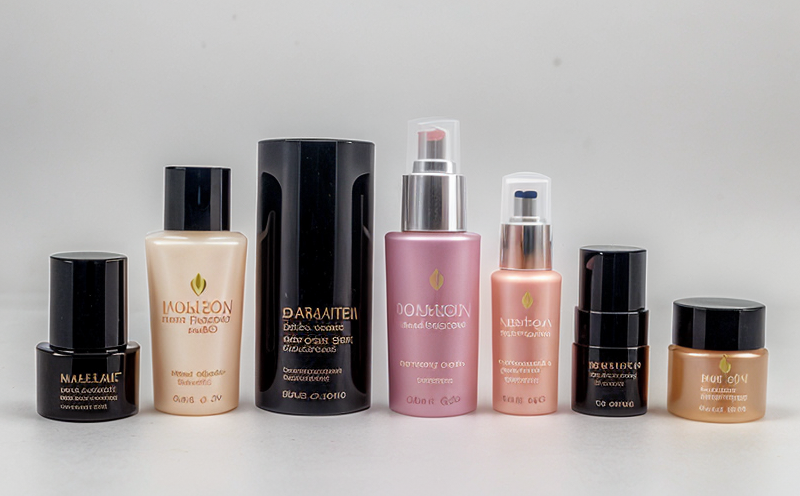Water Vapor Transmission Rate Testing in Cosmetic Packaging
The water vapor transmission rate (WVTR) testing of cosmetic packaging is a critical aspect of ensuring product integrity and quality. Water vapor can penetrate through various materials, potentially affecting the shelf life, efficacy, and sensory qualities of cosmetics. This test assesses how much moisture passes through the packaging material over time under specific conditions.
The importance of WVTR testing cannot be overstated in the cosmetic industry. Products like moisturizers, lotions, serums, and other emulsions are sensitive to water vapor exposure. Excessive moisture can lead to product spoilage or alteration of formulation properties, impacting both consumer satisfaction and brand reputation.
For instance, a high WVTR value might indicate that the packaging is not suitable for products that require long-term storage without compromising their integrity. Conversely, low WVTR values suggest robust protection against moisture ingress but may also impede the natural evaporation of water from certain formulations like serums or creams.
Testing involves placing a specimen under controlled conditions where temperature and relative humidity are precisely regulated to simulate real-world environmental factors. The specimen is typically exposed to these conditions for several days, during which time changes in weight due to vapor transmission are measured. This process helps determine the permeability of different packaging materials such as plastic films, metal foils, or composite structures.
The testing apparatus used for this purpose includes chambers capable of maintaining stable temperature and humidity levels. The specimens are placed inside these chambers with reference materials that help calibrate the test results accurately. The testing duration can vary from a few hours to several days depending on the desired precision level.
Once testing is complete, the data collected is analyzed to calculate the WVTR value in units like grams per square meter per day (g/m²/day). This figure provides insights into the effectiveness of the packaging material against moisture ingress. Compliance with industry standards such as ISO 15106-3 or ASTM D3985 ensures that the packaging meets regulatory requirements and performs consistently across different environments.
| Standard | Description |
|---|---|
| ISO 15106-3:2017 | Absorption and moisture permeation by packaging materials for pharmaceutical products. |
| ASTM D3985-09(2014) | Determination of water vapor transmission through plastic sheeting and flexible films. |
Eurolab Advantages
Eurolab offers unparalleled expertise in conducting WVTR testing for cosmetic packaging. Our team of experienced chemists and engineers brings a wealth of knowledge to ensure accurate results every time. With state-of-the-art equipment calibrated according to international standards, we provide precise measurements that are crucial for meeting regulatory expectations.
Our facilities cater specifically to the unique needs of the cosmetics sector, ensuring that our tests reflect real-world conditions as closely as possible. This includes using appropriate reference materials and maintaining strict control over environmental variables throughout the testing process.
We pride ourselves on delivering timely reports complete with detailed analysis and recommendations for improving packaging performance if necessary. By leveraging advanced analytical techniques and adhering to rigorous quality assurance protocols, Eurolab ensures that all clients receive reliable data they can trust.
Our commitment extends beyond just providing test results; we also offer valuable insights into potential issues related to moisture management in cosmetic products. Our engineers collaborate closely with clients during the testing phase, offering guidance on selecting appropriate materials and optimizing packaging designs for better protection against water vapor penetration.
Customer Impact and Satisfaction
The benefits of conducting WVTR tests on cosmetic packaging go beyond mere compliance; they significantly enhance customer satisfaction and brand loyalty. By ensuring that products remain stable throughout their shelf life, manufacturers can maintain consistent quality standards, which ultimately translates to higher consumer trust.
Customers appreciate knowing that the products they purchase will retain their intended properties without being compromised by external factors like humidity or temperature fluctuations. This builds confidence in brands and fosters long-term relationships between consumers and companies.
In addition to enhancing product longevity, successful WVTR testing contributes positively towards environmental sustainability efforts within the industry. Companies that adopt sustainable practices are increasingly favored by environmentally conscious consumers worldwide. By optimizing packaging design through comprehensive WVTR assessments, businesses contribute towards reducing waste while still delivering high-quality products.
Use Cases and Application Examples
| Use Case/Application Example | Description |
|---|---|
| Testing for Moisture-Insensitive Products | This involves assessing the WVTR of packaging used for products like foundations or eye shadows, which are less affected by moisture. |
| Optimizing Packaging Design | Determining optimal material combinations to enhance barrier properties while maintaining breathability necessary for certain formulations. |





